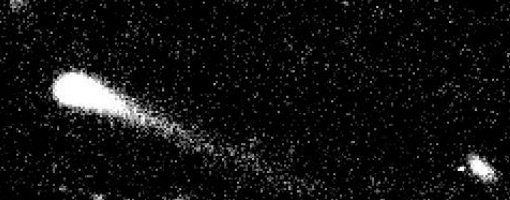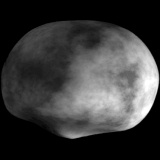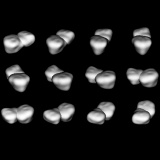 |
|||
|
European Southern Observatory image of P/1997 T3 -
subliming ice from an asteroid, a comet, or a new class of object.
|
|||
| ASTEROID GEOLOGY | |||
| Spacecraft observations are providing a fresh look at the "minor planets" and our understanding of their physical properties and evolution is beginning to progress beyond mere speculation. Such an understanding leads to a greater knowledge concerning the conditions and mechanisms at work during the formation of the Solar System. | |||
| Asteroid evolution | |||
| The very largest asteroids resemble moderate sized moons. 1 Ceres is 933 kilometres across and roughly spherical. The next largest are 2 Pallas, 4 Vesta and 10 Hygiea, which are between 400 and 525 kilometres in diameter. The rest are under 340 kilometres across. | |||
| Such large bodies may have been common in the early Solar System. In orbit between Mars and Jupiter there may have been lots of 1000 kilometre diameter Ceres-like bodies. These would have grown like the other terrestrial planets, Mars, Venus, Earth, and Mercury, via accretion, drawing in material ever more effectively as they increased in mass and gravitational strength. In such large bodies, there would have been enough heat to sustain a molten interior and allow differentiation into a layered planet with an iron core mantled by silicate rocks. Analysis of Vesta's surface shows that it has a basaltic (volcanic) mineralogy. | |||
 Computer-modelled view of Vesta based on Hubble Space Telescope observations. |
|||
| Something happened in the new Solar System to endow these bodies with a tendency to strike one another at high speeds and fragment, allowing only a few fortunate examples of the larger ex-planets to survive. | |||
| A large planetesimal (no longer in existence) may have moved through the asteroid belt, stirring up the smaller asteroids and sending them into erratic and elongated orbits. This started them colliding with each other at high speeds. Alternatively, it has been suggested that the gravitational effect of Jupiter alone was enough to influence the orbits of the asteroids and prevent them from accreting. | |||
 The asteroids tend to orbit in the main belt. |
|||
| Observation | |||
| In encounters with asteroids, the spacecraft/asteroid interactions, as well as the instruments carried, are used to glean as much information as possible. The gravitational pull on the NEAR spacecraft was used to determine the mass of 253 Mathilde and calculate its density. Density is used in conjunction with spectral data in determining composition and likely structure. | |||
 NEAR image of asteroid 253 Mathilde. |
|||
| Galileo's approach of Ida fuelled the debate on the abundance of binary objects in the Solar System, adding substance to the argument that binary objects, like the Ida-Dactyl system or contact binaries like the Trojan 624 Hector, Castalia, and Toutatis, are a commonplace result of asteroid collisions. | |||
 Galileo image of asteroid 243 Ida. |
 Radar image of asteroid 4179 Toutatis. |
 Computer-modelled views of 4769 Castalia based on radar data. |
|
| Both the NEAR and Galileo spacecraft carried sophisticated cameras, which comprise an array of light sensitive elements called a CCD or Charge Coupled Device. Their CCD cameras could take pictures outside the visible spectrum, revealing subtle and otherwise invisible colour differences, differences which are explained by variations in surface composition. | |||
| Surface and geology | |||
| The colour of asteroids varies in the visible spectrum and at wavelengths of light beyond human vision. Because compounds reflect and absorb light differently, the spectral signature can be used to identify the materials present on the surfaces and the rocks excavated by meteorite impacts. Knowing what the surface is made of is crucial to understanding the asteroids and their role in the evolution of the Solar System. | |||
| Much of what we know of asteroids though, comes from careful study of meteorites found on Earth and what their chemistry can tell us about the conditions of formation. There are two main types of asteroid. They are type C and type S, both found in the main asteroid belt. There are others, for example, the M type, but these are less common. | |||
| Carbonaceous C-Type | |||
| Carbonaceous or C-type asteroids account for roughly 75% of the total. They are very dark and have a very low albedo, typically about 0.03. They comprise carbonaceous chondrite material. "Chondrite" signifies that they contain chondrules, globules of silicate rock condensed from the primordial solar nebula. Mathilde is a C-type asteroid. | |||
| Stony-iron S-Type | |||
| Stony-iron or S-types make up about 17% of known asteroids. They are brighter than C-types and each has an albedo of 0.10 to 0.20, reflecting between 10% and 20% of the light which reaches their surface. They are metallic. Earth based observations indicate that they are composed of nickel, iron and contain some magnesium and silicate rocks. Unlike C-types, which are said to be primitive, S-types are altered. S-types are thought to have evolved, either as part of a planet, or a large asteroid like 1 Ceres or 4 Vesta, which has differentiated. Gaspra and Ida Dactyl are S-type asteroids. | |||
| Metallic M-Type | |||
| Most of the rest of the asteroids are M-types, which are relatively bright with albedo values in the range of 0.10 to 0.18, and a composition dominated by metallic iron. European Southern Observatory image of P/1997 T3 - subliming ice from an asteroid, a comet, or a new class of object. | |||
|
|
|||